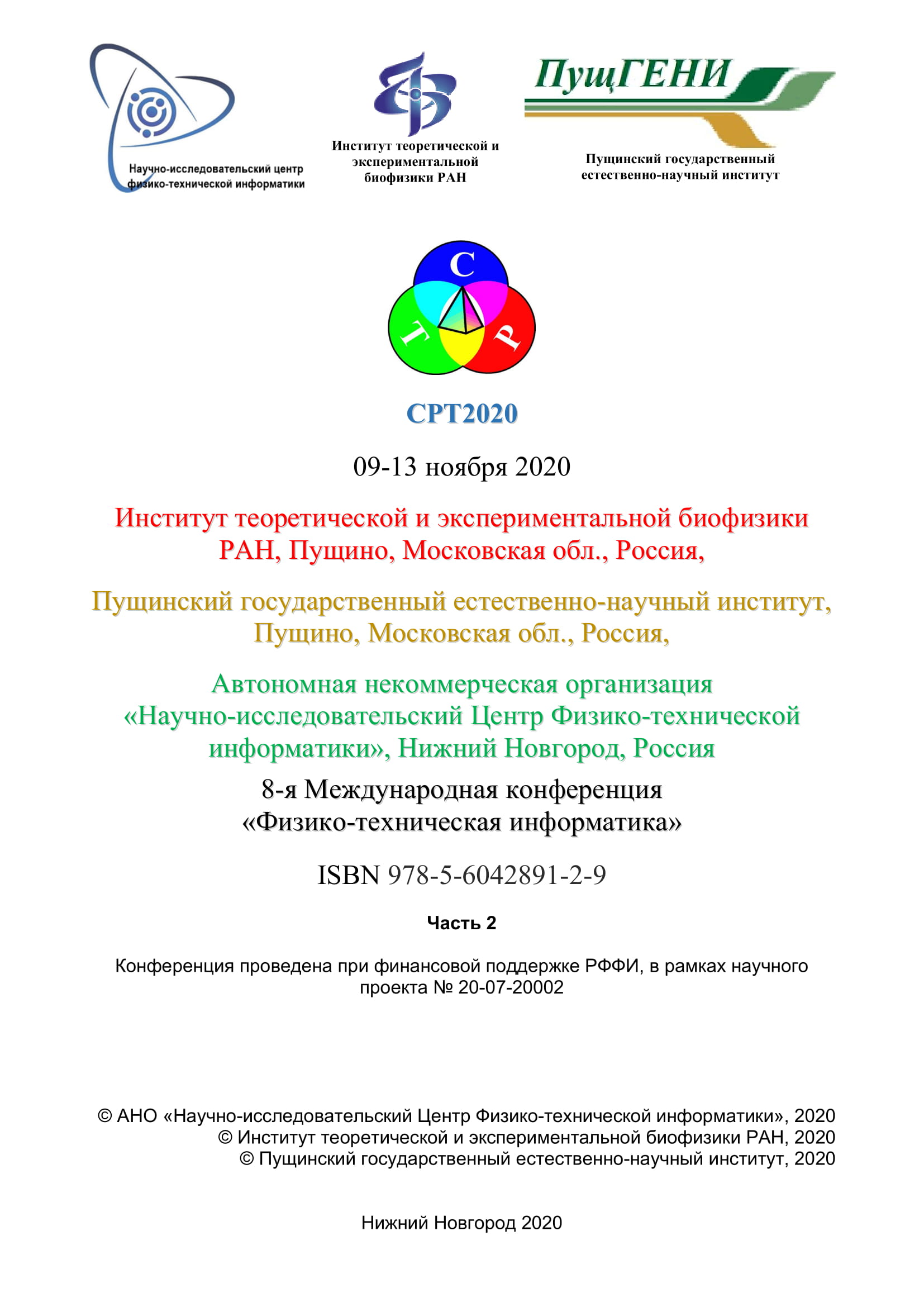Ufa, Russian Federation
Ufa, Russian Federation
Ufa, Russian Federation
Ufa, Russian Federation
CSCSTI 27.43
Russian Classification of Professions by Education 01.03.02
Russian Library and Bibliographic Classification 221
Russian Trade and Bibliographic Classification 6117
With the advent of new sources and technologies for obtaining data on the location and mutual location of objects and systems in general, as well as their integration into real – time control methods and algorithms, conditions have been created for more modern and high-quality use of computer technologies in the management of complex distributed systems (SRS). The components of such SRS are themselves complex distributed systems and have (or can potentially have), among other things, a negative impact on each other, that is, they represent or form a threat to each other. One of the most urgent tasks of our time is to develop various, usually highly computerized, tools and methods for parrying threats based on monitoring and forecasting the development of processes (including physical ones) that form the basis of these threats. This article discusses the problem of parrying one of the types of threats – flood. The issues of using various types of information coming from various sources – sensors for monitoring and forecasting the water level and associated flooding of the corresponding territories are considered. The system of using real-time automatically measured SRS parameters and their further application for digital decision support for parrying threats is a complex highly computerized technical system belonging to the class of the Internet of things. At the same time, it is one of the digital subsystems of the SRS that have a positive impact on other components of the SRS as a whole. All this information comes from various (technically and departmental) heterogeneous sources, so for its rapid and high-quality storage and use for monitoring, forecasting and parrying threats to the SRS, it needs specialized methods of analysis, structuring and distributed storage.
Multi-sensor systems, complex distributed systems, threat parry, forecasting development, spatial data, flood, flooded area
1. Efremova O.A. Algoritm postroeniya zon faktiche-skogo zatopleniya mestnosti pri razlivah rek na os-nove radiolokacionnyh kosmicheskih snimkov i ana-liza harakternyh tochek rel'efa / O.A. Efremova, Yu. N. Kunakov, S. V. Pavlov, A. H. Sultanov // Komp'yu-ternaya optika. - 2018. - Tom 42. - S. 695-703.
2. Krymskiy V.G. Informacionnoe obespechenie ocen-ki sostoyaniya vodnyh resursov i upravleniya imi na osnove geoinformacionnyh tehnologiy: Monogra-fiya. / V.G. Krymskiy, S.V. Pavlov , O.I. Hristodulo ̶ Moskva: Izd-vo «OOO Data+»., 2010 g. ̶ 276 s.
3. Pavlov S.V. Razrabotka geoinformacionnoy modeli rechnoy seti s uchetom kartograficheskoy, gidrologi-cheskoy i morfometricheskoy informacii dlya opre-deleniya granic zon podtopleniya pri izmenenii urovnya vody v vodnyh ob'ektah // S.V. Pavlov, O.I. Hristodulo, R.R. Sharafutdinov // Vestnik UGATU: Nauchnyy zhurnal Ufimsk. gosud. aviac. tehn. un-ta. ̶ 2008. ̶ T. 11, №1 (28). ̶ S. 18-27.
4. Pavlov S.V. Postroenie zon fakticheskogo zatople-niya mestnosti pri razlivah rek na osnove obrabotki radiolokacionnyh kosmicheskih snimkov i analiza harakteristik tochek rel'efa / S.V. Pavlov, Yu. K. Kunakov // Vestnik UGATU: Nauchnyy zhurnal Ufimsk. gosud. aviac. tehn. un-ta. ̶ 2009 g. ̶ T. 13, №2(35). - S. 3 - 10
5. Pavlov S.V. Informacionnoe soprovozhdenie vesen-nego polovod'ya na territorii Respubliki Bashkor-tostan s ispol'zovaniem GIS - tehnologiy / S.V. Pavlov, Yu.N. Kunakov, I.U. Yamalov, A.F. Atnabaev // Vestnik UGATU: Nauchnyy zhurnal Ufimsk. gosud. aviac. tehn. un-ta. - 2011 g - T. 15, №2(42). - S. 29 - 38
6. Barbetta S., Coccia G., Moramarco T., Todini E., «Real-time flood forecasting downstream river confluences us-ing a Bayesian approach», Journal of Hydrology, vol. 565, 2018, pp. 516-523.
7. Bonakadri H., Zaji A.H., Binns A.D., Gharabaghi B., «Integrated Markov chains and uncertainty analysis techniques to more accurately forecast floods using sat-ellite signals», Journal of Hydrology, vol. 572, 2019, pp. 75-79.
8. Chang C.H., Lee H., Hossain F., Basnayke S., Jaya-singhe S., Chishtie F., Saah D., Hanwen Yu., Sothea K., Bui D.D., «A model-aided satellite-altimetry-based flood forecasting system for the Mekong River», Environmen-tal Modelling & Software, 2019, vol. 112, pp. 112-127.
9. Kim K., Pant P., Yamashita E., «Integrating travel de-mand modeling and flood hazard risk analysis for evac-uation and sheltering», International Journal of Disaster Risk Reduction, vol. 31, 2018, pp. 1177-1186.
10. Noymanee J., Theeramunkong T., «Flood Forecasting with Machine Learning Technique on Hydrological Modeling», Procedia Computer Science, vol. 156, 2019, pp. 377-386.
11. Policelli F., Hubbard A., Chul Jung H., Zaitchik B., Ichoku C. «A predictive model for Lake Chad total sur-face water area using remotely sensed and modeled hy-drological and meteorological parameters and multivari-ate regression analysis», Journal of Hydrology, vol. 568, 2019, pp. 1071-1080.
12. Shafizadeh-Moghadam H., Valave R., Shahabi H., Chapi K., «Shirzadi A. Novel forecasting approaches using combination of machine learning and statistical models for flood susceptibility mapping», Journal of Environ-mental Management, 2018, vol . 217, pp. 1-11.
13. Wing O.E.J., Sampson C.C., Bates P.D., «A flood inun-dation forecast of Hurricane Harvey using a continental-scale 2D hydrodynamic model», Journal of Hydrology X, vol. 4, 2019, P. 1-17.
14. Wesemael A.V., Landuyt L., Lievens H., Verhoest N., «Improving flood inundation forecasts through the as-similation of in situ floodplain water level measurements based on alternative observation network configura-tions», Advances in Water Resources, vol. 130, 2019, pp. 229-243.
15. Zhou Y., Guo S., Chang F., «Explore an evolutionary recurrent ANFIS for modelling multi-step-ahead flood forecasts», Journal of Hydrology. 2019. Vol. 570. pp. 343-355.





